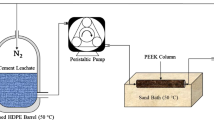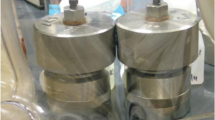Abstract
We study opportunities for CO2 sequestration in geological formations of the state North Rhine Westphalia in Germany. Simulations are performed for evaluating a potential site within the Bunter sandstone formation near the town of Minden in a depth of around 3,000 m using the numerical simulator TOUGHREACT. Our focus is on three CO2 storage mechanisms: (1) hydrodynamic trapping, (2) dissolution trapping, and (3) mineral trapping. The results show that due to buoyancy the injected CO2 phase initially migrates towards the top of the reservoir and is hydrodynamically trapped beneath the confining layer of the cap rock. Then, the CO2 spreads laterally and dissolves partially in the formation water. The dissolution of CO2 results in an increase of the density of the brine causing a downward migration until it settles after 10,000 years at the bottom of the reservoir. The simulations indicate that after 10,000 years, 15% (17 Mt) from a total of 114 Mt injected CO2 are trapped hydrodynamically, 20% (23 Mt) are trapped by dissolution, and 65% (74 Mt) are fixed in newly formed carbonates such as dawsonite, ankerite, and siderite. Within our study pressure increases near the injection well by a factor of 1.1 which is lower than the upper limit usually accepted in gas storage operations. The mineral reactions cause a net decrease of porosity and in turn a decrease of permeability down to 9% of the initial value in parts of the reservoir.



















Similar content being viewed by others
Notes
The complete confidential report is under the permission of the Ministry of Economics of NRW.
References
Anonymous (Undated). Heyden coal-fired power plant. www.eon-kraftwerke.com. Hannover: E.ON Kraftwerke GmbH.
Audigane, P., Gaus, I., Czernichowski-Lauriol, I., Pruess, K., & Xu, T. (2007). Two-dimensional reactive transport modeling of CO2 injection in a saline aquifer at the Sleipner site. American Journal of Science, 307, 974–1008.
Baldschuhn, R., Binot, F., Fleig, S., & Kockel, F. (2001). Tectonic atlas of Northwest Germany and the German North Sea sector—structures, structural development, palaeogeography. In: Geologisches Jahrbuch: Reihe A, Heft 153. Hannover: Federal Institute of Geosciences and Natural Resources (BGR).
Bentham, M. (2006). An assessment of carbon sequestration potential in the UK-Southern North Sea case study. Tyndall Centre for Climate Change Research and British Geological Survey. Keyworth, Nottingham, UK: Kingsley Dunham Centre.
Bruno, M. S., Dewolf, G., & Foh, S. (2000). Geomechanical analysis and decision analysis for delta pressure operations in gas storage reservoirs. In Proc. AGA operations conf., Denver, Colorado, USA. California: Terralog Technologies Inc. (TTI).
Carman, P. C. (1956). Flow of gases through porous media. London: Butterworth Scientific Publications.
Class, H., Ebigbo, A., Helmig, R., Dahle, H. K., Nordbotten, J. M., Celia, M. A., et al. (2009). A benchmark study on problems related to CO2 storage in geologic formations, summary and discussion of the results. Computational Geosciences, 13, 409–434.
Corey, A. T. (1954). The interrelation between gas and oil relative permeabilities. Producers Monthly, 19, 38–41.
Farajzadeh, R., Delil, H. A., Zitha, P. L. J., & Bruining, J. (2007). Enhanced mass transfer of CO2 into water and oil by natural convection. In: SPE EUROPEC/EAGE conference and exhibition, 11–14 June 2007, London, U.K. http://www.onepetro.org/mslib/servlet/onepetropreview?id=SPE-107380-MS&soc=SPE.
Farajzadeh, R., Salimi, H., Zitha, P. L. J., & Bruining, J. (2007). Numerical simulation of density-driven natural convection in porous media with application for CO2 injection projects. International Journal of Heat and Mass Transfer, 50, 5054–5064.
Farajzadeh, R., Meulenbroek, B., & Bruining, J. (2011). An analytical method for predicting the performance of gravitationally-unstable flow in porous media. In: SPE EUROPEC/EAGE annual conference and exhibition held in Vienna, Austria, 23–26 May 2011. http://publicationslist.org/data/rfarajzadeh/ref-39/SPE143420_Final.pdf.
Gaus, I., Azaroual, M., & Czernichowski-Lauriol, I. (2005). Reactive transport modeling of the impact of CO2 injection on the clay cap rock at Sleipner (North Sea). Chemical Geology, 217, 319–337.
Gherardi, F., Xu, T., & Pruess, K. (2007). Numerical modeling of self-limiting and self-enhancing cap rock alteration induced by CO2 storage in a depleted gas reservoir. Chemical Geology, 244, 103–129.
Holloway, S., Vincent, C. J., Bentham, M. S., & Kirk, K. L. (2006). Top-down and bottom-up estimates of CO2 storage capacity in the United Kingdom sector of the southern North Sea basin. Environmental Geosciences, 13, 71–84.
Holt, T., Jensen, J. I., & Lindeberg, E. (1995). Underground storage of CO2 in aquifers and oil reservoirs. Energy Conversion and Management, 36, 535–538.
Hovorka, S. D., Doughty, C., & Holtz, M. (2004). Testing efficiency of storage in the subsurface: Frio brine pilot experiment. Lawrence Berkeley National Laboratory Report LBNL-55730.
Huffmann, H. (1954). Mineralogische Untersuchungen an fünf Bodenprofilen über Basalt, Muschelkalk und Buntsandstein. Heidelberger Beiträge zur Mineralogie und Petrographie, 4, 67–88.
Johnson, J. W., Nitao, J. J., & Morris, J. P. (2004). Reactive transport modeling of cap rock integrity during natural and engineered CO2 storage. In T. David, & S. Benson (Eds.), Carbon dioxide capture for storage in deep geologic formations. Amsterdam: Elsevier. ISBN 0080445705.
Kaszuba, J., Janecky, D., & Snow, M. (2003). Carbon dioxide reaction processes in a model brine aquifer at 200°C and 200 bars: Implication for geologic sequestration of carbon. Applied Geochemistry, 18, 1065–1080.
Kühn, M., Bartels, J., & Iffland, J. (2002). Predicting reservoir property trends under heat exploitation: interaction between flow, heat transfer, transport, and chemical reactions in a deep aquifer at Stralsund, Germany. Geothermics, 31, 725–749.
Lagneau, V., Pipart, A., & Catalette, H. (2005). Reactive transport modelling of CO2 sequestration in deep saline aquifers. Oil and Gas Science and Technology - Rev. IFP, 60, 231–247.
May, F., Krull, P., & Gerling, P. (2004). CO2 storage scenarios in North Germany GESTCO project case studies. In BGR internal report. Hannover: Federal Institute of Geosciences and Natural Resources (BGR).
Mo, S., Zweigel, P., Lindeberg, E., & Akervoll, I. (2005). Effect of geologic parameters on CO2 storage in deep saline aquifers. In: SPE EUROPEC/EAGE annual conference, 13–16 June 2005, Madrid, Spain. http://www.onepetro.org/mslib/servlet/onepetropreview?id=SPE-93952-MS&soc=SPE.
Naderi Beni, A. (2011). Multi-phase, multi-species reactive transport modeling as a tool for system analysis in geological carbon dioxide storage. PhD thesis. Aachen: E.ON Eneregy Research Center, RWTH Aachen University.
Naderi Beni, A., Clauser, C., & Erlström, M. (2011). System analysis of underground CO2 storage by numerical modeling for a case study in Malmö. American Journal of Science, 311, 335–368.
Pape, H., Clauser, C., & Iffland, J. (1999). Permeability prediction based on fractal pore-space geometry. Geophysics, 64, 447–1460.
Peaceman, D. W. (1977). Fundamentals of numerical reservoir simulation. Amsterdam: Elsevier Scientific.
Pruess, K., Xu, T., Apps, J., & García, J. (2003). Numerical modeling of aquifer disposal of CO2. SPE Journal, 83695, 49–60.
Riaz, A., Hesse, M., Tchelepi, H. A., & Orr Jr., F. M. (2006). Onset of convection in a gravitationally unstable diffusive boundary layer in porous media. Journal of Fluid Mechanics, 548, 87–111.
Riddiford, F., Wright, I., Espie, T., & Torqui, A. (2005). Monitoring geological storage: In Salah gas CO2 storage project. In M. Wilson, T. Morris, J. Gale, & K. Thambimuthu (Eds.), Greenhouse gas control technologies, proceedings from the 7th greenhouse gas control technologies conference, 5–9 September 2004, Vancouver, Canada (Vol. 2, pp. 1353–1359). London: Elsevier.
Saadatpoor, E., Bryant, S., & Sepehrnoori, K. (2009). Effect of capillary heterogeneity on buoyant plumes: A new local trapping mechanism. Energy Procedia, 1, 3299–3306.
Seidel, M. (2004). Gefügeabhängige Verwitterung von Sandsteinen durch Kristallisation von Eis und Salzen im Porenraum. Diplomarbeit, Georg August Universität, Göttingen.
Torp, T. A., & Gale, J. (2004). Demonstrating CO2 storage: The Sleipner and SACS projects. Energy, 9, 1361–1369.
Valeton, I. (1953). Petrographie des süddeutschen Hauptbuntsandsteins. Heidelberger Beiträge zur Mineralogie und Petrographie, 3, 335–379.
van der Meer, L. G. H., & van Wees, J. D. (2006). Effects of CO2 solubility on the long-term fate of CO2 sequestered in a saline aquifer. The Leading Edge, 25, 1276–1280.
van Genuchten, M. T. (1980). A closed-form equation for predicting the hydraulic conductivity of unsaturated soils. Soil Science Society of America Journal, 44, 892–898.
Xu, T., & Pruess, K. (1998). Coupled modeling of non-isothermal multiphase flow, solute transport and reactive chemistry in porous and fractured media: 1. Model development and validation. Lawrence Berkeley National Laboratory Report LBNL-42050.
Xu, T., & Pruess, K. (2001). Modeling multiphase non-isothermal fluid flow and reactive geochemical transport in variably saturated fractured rocks: 1. Methodology. American Journal of Science, 301, 16–33.
Xu, T., Apps, J. A., & Pruess, K. (2003). Reactive geochemical transport simulation to study mineral trapping for CO2 disposal in deep arenaceous formations. Journal of Geophysical Research, 108, 2071–2083.
Xu, T., Apps, J. A., & Pruess, K. (2004). Numerical simulation of CO2 disposal by mineral trapping in deep aquifers. Applied Geochemistry, 19, 917–936.
Xu, T., Ontoy, Y., Molling, P., Spycher, N., Parini, M., & Pruess, K. (2004). Reactive transport modeling of injection well scaling and acidizing at Tiwi Field, Philippines. Geothermics, 33, 477–491.
Xu, T., Sonnenthal, E., Spycher, N., & Pruess, K. (2004). TOUGHREACT user’s guide: A simulation program for non-isothermal multiphase reactive geochemical transport in variably saturated geologic media. Lawrence Berkeley National Laboratory Report LBNL-55460.
Xu, X., Chen, S., & Zhang, D. (2006). Convective stability analysis of the long-term storage of carbon dioxide in deep saline aquifers. Advances in Water Resources, 29, 397–407.
Acknowledgement
The authors thank the WestLB Foundation Zukunft NRW (Future NRW) for supporting this project and the anonymous reviewer for constructive comments.
Author information
Authors and Affiliations
Corresponding author
Rights and permissions
About this article
Cite this article
Naderi Beni, A., Kühn, M., Meyer, R. et al. Numerical Modeling of a Potential Geological CO 2 Sequestration Site at Minden (Germany). Environ Model Assess 17, 337–351 (2012). https://doi.org/10.1007/s10666-011-9295-x
Received:
Accepted:
Published:
Issue Date:
DOI: https://doi.org/10.1007/s10666-011-9295-x




